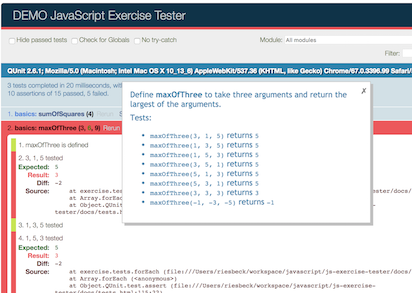js-exercise-tester
This is an evolving set of introductory exercises for JavaScript, with test cases. The exercises emphasize modern JavaScript iteration methods, such as map and filter, over the older while and for forms.
This is neither a tutorial, nor an attempt at an exhaustive set of exercises. The goal is to offer some simple challenges that are not completely inane.
The demo tests.html shows the interface, with just a few exercises specified, one solved, and one partially solved.
Getting Started
You need one HTML file to test code in a JavaScript file you create.
Prerequisites
- Any modern web browser with a developer console, such as Chrome or Firefox
- A good text editor, such as Visual Studio Code, BBedit, or Sublime, for editing your JavaScript file
Installing
- Download tests.html into a folder.
- Create an empty text file called solutions.js in the same folder.
- Open tests.html in your browser to see the QUnit report on tests passed and failed.
Initially all tests will fail because you have not defined any functions.
The Exercises
The exercises are divided into modules.
- basics: solutions involve functions, variables, calculation, and conditionals
- arrays: solutions involve arrays of both simple data and JavaScript objects, and operations that loop over such arrays
- strings: solutions involve strings, string operations, and loops over arrays of strings
Topics accumulate. Solutions to exercises in later modules will often require topics from earlier modules. Earlier exercises have simpler solutions, so do them in order.
Most exercises can be done with one short function, but feel free to define helper functions if they make your solution clearer.
- Click ? to see what the exercise asks for.
- Write a function definition in your file solutions.js that you think will work.
- Save that file, and load (or reload) your local copy of tests.html in your browser.
- The page will show which tests your code passed, and the first one that failed.
- Fix your code until it passes all the tests.
Hint: Open the developer console in your browser when working on exercises. That way you'll see any error messages that happen when your code is loaded or run. Some browsers won't reload a changed JavaScript source file unless the developer window is open.
Work your way down the list of exercises.
Unless specified otherwise by the exercise requirements, solution code should not
- modify input objects
- print anything
Example
The first exercise is sumOfSquares.
Clicking on ? next to sumOfSquares shows that you need to define a function sumOfSquares to take two numbers, square them, and return the sum. The description includes the tests cases your code needs to pass, e.g., sumOfSquares(3, 4) should return 25, i.e., 3 squared plus 4 squared.
Put the following deliberately wrong code into your file solutions.js, so that you can see what partial success looks like.
function sumOfSquares(x, y) {
return 25;
}
Save solutions.js and reload test.html. The report should show that the some tests pass, but some fail.
Now change your solution to the correct code:
function sumOfSquares(x, y) {
return x * x + y * y;
}
Save solutions.js and reload test.html. The report should show that all tests for sumOfSquares pass. To see what those tests were, click on the sumOfSquares label in the report.
Resources
A readable, reasonably up to date, reference that covers all the JavaScript you need is The Modern JavaScript Tutorial.
For more on using the QUnit test interface, see this tutorial.
Built With
- QUnit - The in-browser testing framework used
Authors
- Chris Riesbeck - Initial work - home page
License
This project is licensed under the MIT License - see the LICENSE.md file for details
Acknowledgments
- Hat tip to QUnit for in-browser testing and lots of hooks
